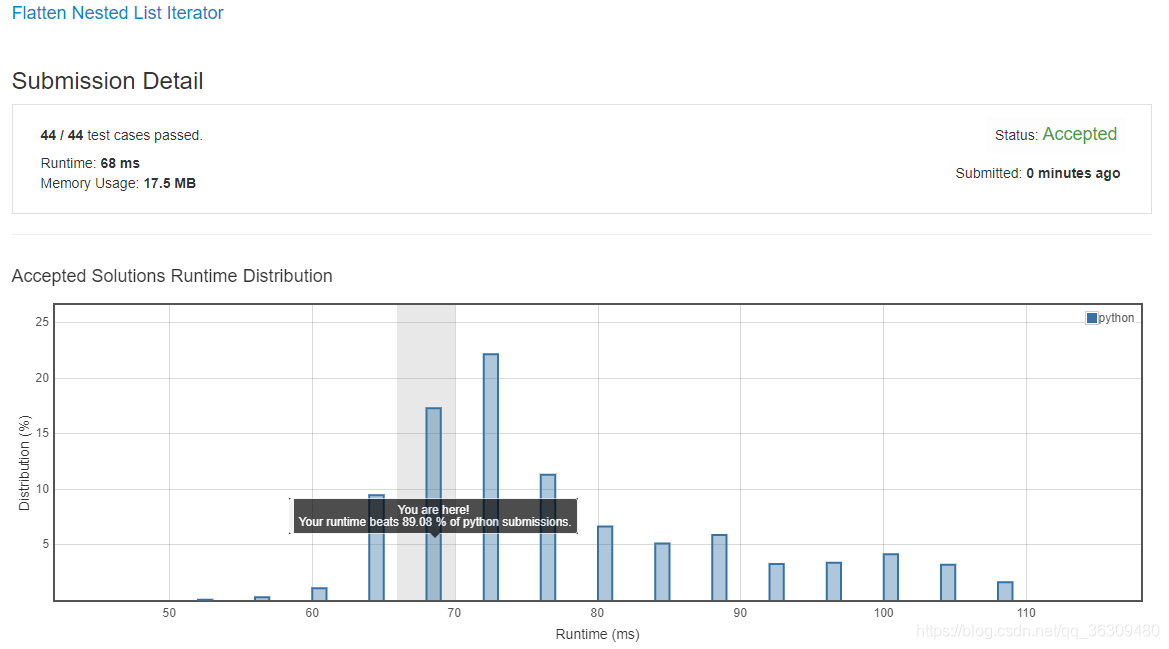341. 扁平化嵌套列表迭代器
给定一个嵌套的整型列表。设计一个迭代器,使其能够遍历这个整型列表中的所有整数。
列表中的项或者为一个整数,或者是另一个列表。
示例 1:
输入: [[1,1],2,[1,1]] 输出: [1,1,2,1,1] 解释: 通过重复调用 next 直到 hasNext 返回false,next 返回的元素的顺序应该是: [1,1,2,1,1]。
示例 2:
输入: [1,[4,[6]]] 输出: [1,4,6] 解释: 通过重复调用 next 直到 hasNext 返回false,next 返回的元素的顺序应该是: [1,4,6]。
解题思路:代码核心是使用一个队列存储所有整数。在存储数据时,对于嵌套的整型列表中的每个元素,使用class NestedInteger()中的函数判断其是否为单独的整数,若是,直接向队列中添加;否则,递归调用函数。
Python3代码如下:
# """
# This is the interface that allows for creating nested lists.
# You should not implement it, or speculate about its implementation
# """
#class NestedInteger(object):
# def isInteger(self):
# """
# @return True if this NestedInteger holds a single integer, rather than a nested list.
# :rtype bool
# """
#
# def getInteger(self):
# """
# @return the single integer that this NestedInteger holds, if it holds a single integer
# Return None if this NestedInteger holds a nested list
# :rtype int
# """
#
# def getList(self):
# """
# @return the nested list that this NestedInteger holds, if it holds a nested list
# Return None if this NestedInteger holds a single integer
# :rtype List[NestedInteger]
# """
class NestedIterator(object):
def __init__(self, nestedList):
"""
Initialize your data structure here.
:type nestedList: List[NestedInteger]
"""
self.queue = collections.deque()
def f(nestedList):
for nested in nestedList:
if nested.isInteger():
self.queue.append(nested.getInteger())
else:
f(nested.getList())
f(nestedList)
def next(self):
"""
:rtype: int
"""
return self.queue.popleft()
def hasNext(self):
"""
:rtype: bool
"""
return len(self.queue) > 0
# Your NestedIterator object will be instantiated and called as such:
# i, v = NestedIterator(nestedList), []
# while i.hasNext(): v.append(i.next())






 博客围绕扁平化嵌套列表迭代器展开,给定嵌套整型列表,需设计迭代器遍历其中所有整数。列表项可为整数或另一列表。解题核心是用队列存储整数,对嵌套列表元素用特定函数判断,若是整数直接添加,否则递归调用函数,还给出了Python3代码。
博客围绕扁平化嵌套列表迭代器展开,给定嵌套整型列表,需设计迭代器遍历其中所有整数。列表项可为整数或另一列表。解题核心是用队列存储整数,对嵌套列表元素用特定函数判断,若是整数直接添加,否则递归调用函数,还给出了Python3代码。
















 464
464

 被折叠的 条评论
为什么被折叠?
被折叠的 条评论
为什么被折叠?








